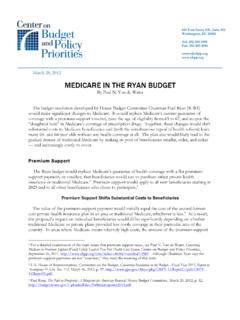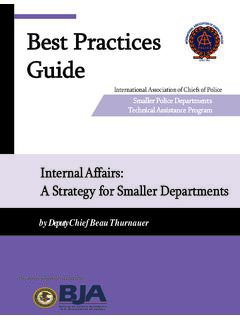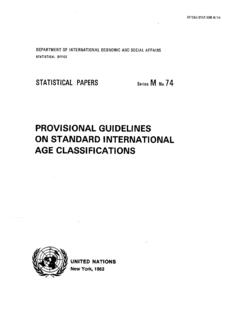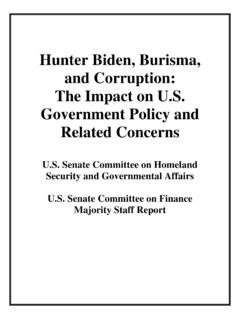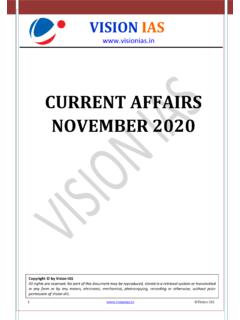Transcription of Where Do Our Federal Tax Dollars Go?
1 policy Basics is a series of brief background reports on issues related to budgets, taxes, and government assistance programs. Center on Budget and policy Priorities | Where Do Our Federal Tax Dollars Go? The Federal government collects taxes to finance various public services. As policymakers and citizens weigh key decisions about revenues and expenditures, it is important to examine what the government does with the money it collects. Note: We use estimates for 2022 rather than 2021 to illustrate the composition of the Federal budget and taxes under more normal circumstances, with most of the costs of the 2020 and 2021 COVID-19 relief packages having expired. Still, total Federal spending in 2022 is about $600 billion higher than it would have been without the relief packages; while eight-tenths of Federal pandemic spending was delivered in 2020 and 2021, some primarily for health care, state and local education, and individual assistance (such as through the Child Tax Credit) occurs in 2022.
2 In fiscal year 2022, the Federal government is estimated to spend $ trillion, amounting to percent of the nation s gross domestic product (GDP). Of that $ trillion, over $ trillion is estimated to be financed by Federal revenues. The remaining amount will be financed by net borrowing. As the chart below shows, three major areas of spending make up the majority of the budget: Social Security: In 2022, 21 percent of the budget, or $ trillion, will be paid for Social Security, which will provide monthly retirement benefits averaging $1,538 to 49 million retired workers. Social Security also expects to provide benefits to 3 million spouses and children of retired workers, 6 million surviving children and spouses of deceased workers, and 9 million disabled workers and their eligible dependents.
3 Health insurance: Four health insurance programs Medicare, Medicaid, the Children s Health Insurance Program (CHIP), and Affordable Care Act (ACA) marketplace health insurance subsidies together account for 25 percent of the budget in 2022, or $ trillion. One-half of this amount, or $733 billion, goes to Medicare, which provides health coverage to around 80 million people who are aged 65 and older or have disabilities. The rest of this category funds the Federal costs of Medicaid, CHIP, and ACA subsidy and marketplace costs. (Both Medicaid and CHIP require states to pay some of their total costs.) In a typical month, Medicaid and CHIP provide health care or long-term care to about 87 million low-income children, parents, elderly people, and people with disabilities. In 2022, 13 million of the million people estimated to be enrolled in health insurance through ACA marketplaces received subsidies that lower their premiums and out-of-pocket costs, at an estimated cost of about $82 billion.
4 policy Basics Where Do Our Federal Tax Dollars Go? 2 Defense: Another 13 percent of the budget, or $768 billion, will be paid for national defense activities. About 95 percent of the spending in this category reflects the underlying costs of the Defense Department, largely for operations and maintenance; military personnel; procurement of weapons; and research, development, testing, and evaluation. Three other categories together account for one-quarter of spending: Economic security programs: About 11 percent (or $665 billion) of the Federal budget in 2022 supports programs that provide aid (other than health insurance or Social Security benefits) to individuals and families facing hardship. Economic security programs include: the refundable portions of the Earned Income Tax Credit and Child Tax Credit, which assist low- and moderate-income working families; programs that provide cash payments to eligible individuals or households, including unemployment insurance and Supplemental Security Income for low-income people who are elderly or disabled; various forms of in-kind assistance for low-income people, including the Supplemental Nutrition Assistance Program (formerly known as food stamps), school meals, low-income housing assistance, child care assistance, and help meeting home energy bills; and other programs such as those that aid abused or neglected children.
5 Such programs keep millions of people above the poverty line each year. A forthcoming CBPP analysis using Census data and the Supplemental Poverty Measure (SPM), which accounts for government benefits and taxes, shows that economic security programs lifted 34 million people above the poverty line in 2019, including 6 million children. Not counting any government benefits and tax policies, percent of the population would have had incomes below the poverty line in 2019; this was nearly double the poverty rate of percent using the SPM. And these programs reduced the extent of poverty for millions more, even when not bringing them above the poverty line. While racial inequities continue to exist, a similar CBPP analysis s hows that economic security programs noticeably reduce the racial and ethnic disparities among white, Black, and Hispanic households.
6 Benefits for veterans and Federal retirees: In 2022, about 7 percent of the budget provides benefits to veterans and former career employees of the Federal government, both civilian and military, totaling $420 billion. About nine-tenths of the benefits available to all veterans are either disability policy Basics Where Do Our Federal Tax Dollars Go? 3 payments or medical care, which is often specialized to deal with the unusual conditions that military service may impose. There are currently more than 19 million veterans of military service, of whom million are retired career military who have earned monthly retiree pensions or survivor benefits. There are also million Federal civil service retirees. Interest on debt: The Federal government must make regular interest payments on the money it borrowed to finance past deficits that is, on the net Federal debt, which is projected to reach $ trillion by the end of fiscal year 2022.
7 This year, these interest payments will claim $399 billion, or about 7 percent of the budget. As the chart above shows, the remaining Federal spending supports a variety of other public services. A very small slice 1 percent of the budget goes to programs that operate internationally, including programs providing humanitarian aid and maintaining embassies and consulates. The rest includes investing in education, investing in basic infrastructure such as roads, bridges, and airports; maintaining natural resources, farms, and the environment; investing in scientific and medical research; enforcing the nation s laws to promote justice, and other basic duties of the Federal government. While critics often decry government spending, it is important to look beyond the rhetoric and determine whether the actual public services and investments that government provides are valuable.
8 Ultimately, those services are paid for with tax revenue. Consequently, when thinking about the costs that taxes impose, it is essential to balance those costs against the benefits the nation receives from the expenditure of those funds. Appendix Because we discuss total Federal spending, we do not distinguish programs financed by general revenues from those financed by dedicated revenues (for example, Social Security). For more information, see policy Basics: Federal Payroll Taxes. We based our estimates of spending in fiscal year 2022 on the most recent estimates released by the Congressional Budget office on May 25, 2022. (Fiscal year 2022 runs from October 1, 2021, to September 30, 2022.) The broad expenditure categories presented in this paper were constructed from classifications commonly used by budget agencies.
9 The categories are constructed by grouping related programs and activities into broad functions, which are further broken down into subfunctions. Details on how the categories used in this paper were constructed from those functions and subfunctions are described below. policy Basics Where Do Our Federal Tax Dollars Go? 4 Social Security: This category consists of all expenditures in the Social Security function (650), including both benefits and administrative costs. Health insurance: This category consists of the Medicare function (570), including benefits, administrative costs, and premiums, as well as the Grants to States for Medicaid account, the Children s health insurance fund account, the ACA s Refundable Premium Tax Credit and Cost Sharing Reductions account, and the ACA s Risk Adjustment Program Payments account ( all in function 550).
10 Defense: This category is the national defense function (050). Economic security programs: This category includes all programs in the income security function (600) except those in the following two subfunctions: Federal employees retirement and disability (602) and general retirement and disability insurance (601). The latter contains the Pension Benefit Guarantee Corporation and covers programs that provide pension and disability benefits to certain small groups of private sector workers. Benefits for veterans and Federal retirees: This category combines the veterans benefits and services function (700) and the Federal employee retirement and disability subfunction (602), which is part of the income security function. Interest on debt: This category contains the net interest function (900).


